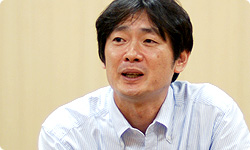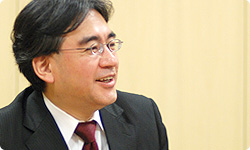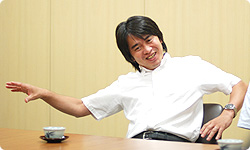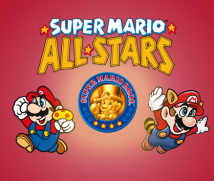4. Gestures in the Night
Kimura-san, you came on board a little after Konno-san and Eguchi-san, and you experienced Miyamoto-san's attention to detail, right?
That's right. As I was saying a little earlier, I was working on all four instalments in the Mario Advance series, and I personally thought New Super Mario Bros. for the Nintendo DS would work well as "5" in that series.
That New Super Mario would be Mario Advance 5?
Yes. After we released Mario Advance 4, people were asking if a "5" in the series would be released. That's right when the Nintendo DS came out, which was perfect timing, so I thought if we're going to make it, it should be a new title.
So basically, if the Mario Advance series was never created, New Super Mario may have never been released.
That's right. It might have been released in a completely different form.
By the way, since we're talking about Mario Advance, I remember when I first came to Nintendo and I was looking at a list of some of the Game Boy Advance titles under development. I noticed there weren't any Mario titles on the list, so I said, "Miyamoto-san, let's make a Mario game too." And that's how the Mario Advance series got started.
Oh, that's right. When it came to Mario software for handheld systems, the Mario Land 23 series was the only thing going at that time. Anyway, we made New Super Mario for the DS, and started development on the Wii version of New Super Mario right after finishing that. Shortly after the development of the game started, Miyamoto-san started to be deeply involved with it. 23Super Mario Land: An action game released for the Game Boy in April 1989 in Japan. In 1992, a second title in the series was released called Super Mario Land 2: 6 Golden Coins, and Super Mario Land 3: Wario Land was released as the third instalment of the series in 1994.

He was involved with that game for a long time. I mean, he'd go on site and hardly ever come back. That's probably the longest he's spent on a game since I became president.
Yeah, and I felt like our team was inconveniencing the rest of the company. (laughs)
Well, the results were good so we can put it behind us. (laughs)
Anyway, that's when I first got a direct taste of Miyamoto-san's attention to detail. For example, when we decided to add the multiplayer feature, I thought if two players could play at once it would be enough.
Why was that?
First of all, what was important was to have simultaneous gameplay in a side-scrolling Mario game, regardless of the number of players. And as a little side information, I have a son, and I personally thought it would be fun enough if my son and I could play a Mario game at the same time.
Then there were no plans to add Toad to the mix for four-player action at first.
Right. So when we made a prototype with a playable Mario and Luigi, and presented it to Miyamoto-san...
He asked you why four people can't play.
Exactly! (laughs).
Sounds like a familiar pattern to me. (laughs)
He made it clear he wanted four-player action, so we hastily changed it to a four-player compatible system.
Already about 20 years ago, Miyamoto-san expressed to me his desire of the simultaneous play of Super Mario by multiple players, so it has been a major goal for him in the long history of the series.
We experimented a little with multiplayer in Mario 3. It was simultaneous gameplay with Mario and Luigi that we tried in that game, but the screen wouldn't pull forward very well when scrolling, so players would fall even though they jumped, and things like that, so it just didn't work out.
Back then we couldn't solve the problem of two players trying to go in different directions without somebody ending up outside the screen. But now with the Wii console it's possible to zoom out for a wider scope of action when players go their separate ways . Nearly 22 years after experimenting with Mario 3, it looks like we finally made it happen. And better yet, with four players instead of two.
Yes. And in the Wii version of New Mario, there's an action where shaking the Wii Remote will make Mario spin, and when we were experimenting with that over and over, Miyamoto-san intuitively came up with shaking the Wii Remote while jumping to increase Mario's hang time a little, so he could jump a little farther than usual, and then he bluntly said, "This is fun, let's put it in."
So when you jump and think you're going to fall before reaching the other end, shaking the Wii Remote instead of giving up will take you somewhere you never thought you'd get to.

Right. And it ended up being another action game with a lot of depth to it. The funny thing is, when I play the Nintendo DS version of New Mario now, without thinking I -
Don't tell me. Without thinking you shake the DS. (laughs)
That's right (laughs). When playing the DS version I really want to stretch out my jumps. Miyamoto-san did a great job matching that new technique up with Mario without a second thought, and that reinforced my opinion of his excellence.
How about you, Koizumi-san? You've worked with Miyamoto-san all the way through the 3D Mario series. Were there any episodes that really left an impression on you?
Yes. I'd have to say the most impressionable experience I had with Miyamoto-san was when we started working on the Mario 6424 prototype. He just came out one day and said, "I'm going to direct this one." I was really shocked when he said that. I mean, Miyamoto-san as director - 24Super Mario 64: Mario's first 3D action game, launched simultaneously with the Nintendo 64 home game console in June 1996 in Japan.
He hadn't directed anything for a long time.
He seemed to be really taken by the freshness of a 3D world, enough to take on the job himself. But after that, I remember he was pretty frustrated day after day.
Because of the challenge involved with taking on an entirely new world of 3D action, I'm sure a lot of problems came up that couldn't be solved.
Uh-huh. And for me, this was the first time I'd ever worked directly with Miyamoto-san, and this being his first time working as director in a long time, I was looking forward to what sort of specs or instruction sheets he had in store for me. But there were almost no instruction sheets to speak of...
He didn't put anything on paper for you?
Well, there was this one scene where Mario was supposed to cross a bridge for example, and Miyamoto-san illustrated it on paper...
Oh, okay. That kind of makes you want to say, "Hey, this isn't an instruction sheet." (laughs)
Right. I was really having a hard time figuring out how to make things move in that scene. I was working away late at night, and all of a sudden Miyamoto-san comes up behind me and starts doing these gestures.
Gestures? (laughs)
(Making a "balancing" gesture) While he was saying, "Not like this... But a little more like this."

(laughs) So Miyamoto-san was trying to tell you how Mario should move through his own gestures?
He'd be saying things like, "His feet should move like this here, and the focal point is right around here..." This was around 2 or 3 in the morning, and pretty much all the development staff had already gone home. So it was just Miyamoto-san and me in the office, and he starts showing me how Mario is supposed to swim while saying, "It's not really a breast stroke, and not a crawl, but something like this maybe...?" And he was completely sprawled out on the desk doing these swimming motions. (laughs)
(laughs)
I really should've snapped some pictures of him doing those gestures. (laughs) But when I looked at him there and noticed he wasn't a bit embarrassed, I thought, "This is the work of a true director." And something I realised later is that drawing up instruction sheets for 3D games is extremely difficult.
Unlike with 2D games, it's definitely a lot harder to explain what you want on paper when it comes to 3D.
Yes... Other than Mario, I was in charge of player design for a 3D Zelda game, and when looking at how the feet run, or various other small details, I really felt like my experience with him during Mario 64 taught me how important it is to get those little details right.
It sounds like Miyamoto-san's late night gestures really helped it sink in.
You could say that. (laugh)
